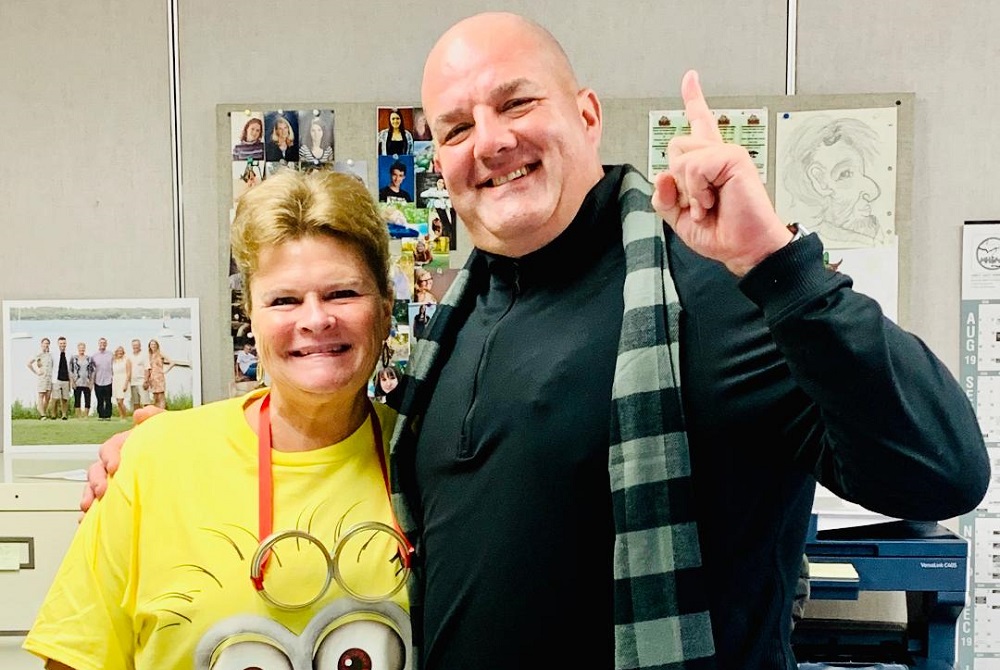
Vicksburg AD Roy Honored Nationally for Service to School Sports
By
Pam Shebest
Special for MHSAA.com
February 15, 2022
VICKSBURG — Accepting an award on a national stage is an impressive feat for any athletic director.
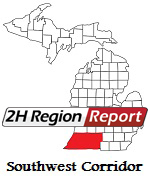 But it was even more special for Vicksburg AD Mike Roy, who shared that stage with his mentor and good buddy.
But it was even more special for Vicksburg AD Mike Roy, who shared that stage with his mentor and good buddy.
While Roy was presented a Distinguished Service Award from the National Interscholastic Athletic Administrators Association in December, retired AD Mike Garvey was inducted into its Hall of Fame.
“This award from the NIAAA was exceptionally special to me because Mike got inducted the very same night into the NIAAA Hall of Fame,” Roy said.
“To be able to receive that award with someone who means so much to me and has guided me and been so influential in my career was the icing on the top, the cherry.”
Garvey said to be mentioned as Roy’s mentor “is an amazing compliment. When the Hall of Fame asked me to send some photos, I had to have him in one.”
The two men first connected 23 years ago when Garvey left Lawton High School for the AD’s job in Delton. Roy filled the Lawton position.
“Mike took me under his wing,” Roy said. “He introduced me to another great friend, Fred Smith.
“Just a couple guys who are awesome gentlemen who are recognized throughout the country.”
Garvey reflects that admiration.
“Mike Roy has been recognized in Michigan and it’s time the rest of the country knows how great he is.” Garvey said.
“It was wonderful to share the stage with him. He’s a high-energy person who attacks everything with vigor. He gets things done.”
Two years ago, Roy received the MHSAA’s Allen W. Bush for service, prompting a Roy-like comment.
“With my joking, sarcastic system, I said to myself, ‘I must be getting old because I’m starting to get these awards and being recognized for it,’” he said.
“But, really, upon hearing it, you just sit back and are really taken aback and humbled by it.”
Rooted in Paw Paw
Roy started his athletic career in Paw Paw with football, basketball, baseball and track in high school.
After turning down offers from Division III schools, Roy accepted a football scholarship to University of Nevada, Las Vegas, which was an eye-opener.
“I found out very quickly when I got to UNLV to play football that I was no longer the big fish in the pond,” he said. “I was a very small fish in a very big pond.
“Going to UNLV forced me to grow up. Sometimes when reality smacks you in the face, it kind of wakes you up.”
That experience helps him guide high school athletes today.
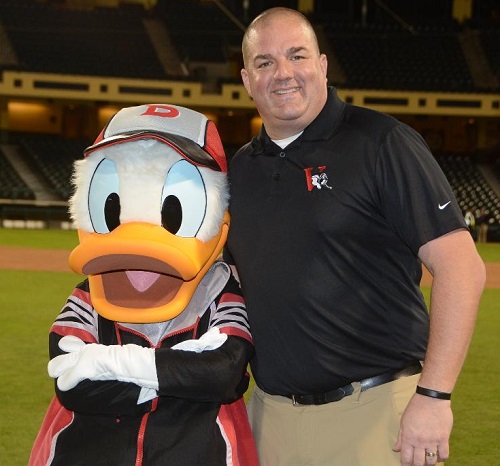 “Looking back now, there are some things I wish I had done on the academic side of it,” he said. “I wasn’t a great student; I wasn’t a terrible student. I wish I had done better.
“Looking back now, there are some things I wish I had done on the academic side of it,” he said. “I wasn’t a great student; I wasn’t a terrible student. I wish I had done better.
“My career goal at that time, wishful as it was, was to be an NFL player.”
At UNLV, Roy earned a bachelor’s degree in physical education and health with an endorsement in driver’s education and a master’s in instructional and curricular studies.
Once back in Michigan, Roy coached golf and strength and conditioning at Kalamazoo Valley Community College, taught strength classes at Western Michigan University and was an assistant to Kalamazoo College men’s basketball coach Joe Hacklin.
Roy applied for a job at Vicksburg High School — which he did not get.
Instead, he was hired to replace Garvey at Lawton, also teaching strength and conditioning, and coaching varsity basketball.
Three years later, Roy became AD at Vicksburg, a job he has had for the last 20 years.
Accolades began piling up, including the certified master athletic administrator designation from the NIAAA in 2005, Michigan Interscholastic Athletic Administrator Association (MIAAA) Athletic Director of the Year in 2012, MIAAA president in 2019-20, NIAAA delegate at the National Federation of State High School Associations (NFHS) national conference for 10 years and being named a finalist for National Athletic Director of the Year from the National High School Coaches Association.
At the NHSCA ceremony, Roy said he noticed one of the other finalists.
“One of the guys, when I looked, I said ‘Oh my gosh. He’s been an AD for 45 years.’
“Here I’m sitting with not even half that under my belt, wondering if I’m going to get 45 years in.”
Ever humble, Roy makes a point several times of mentioning that any award he receives is a culmination of efforts from a great support staff.
“I tell people in my joking way, ‘It’s my ugly face that gets the award, but when people come to Vicksburg they meet my ticket-taker or see my game management is on point,” he said.
“I wouldn’t be able to get half this stuff if I didn’t have the athletic secretary (Rhonda VanderKamp) I have. She’s phenomenal.”
VanderKamp, who has worked with Roy all 20 years, said they work well together.
As for sharing in any awards, “I’m honored but truly he deserves those awards,” she said. “We just complement each other.
“I’m so honored when I attend some of the conferences and they go around the room and ask you how many years you’ve been an athletic secretary and how many ADs have you been through. I can say only just one. It’s awesome.”
Showing off a great home
Under Roy, Vicksburg has hosted more than 100 MHSAA postseason events, and he takes pride in the workers and facilities.
“I’ve always been big on the appearance of our facilities,” he said. “Unfortunately, the outside community doesn’t get to see our library. They don’t get to see our science labs and all the other wonderful things we have going on in the building.
“When they come to Vicksburg, they’re drawing their assumptions on how they’re treated when they walk through the gate, how do the facilities look, are the trash cans overflowing, are things broken.”
He said when the MHSAA asks or looks for people to step up and host tournaments, “We have always been willing to do that. I ask our people and they say yes, we want to bring people to Vicksburg and show off our facilities.”
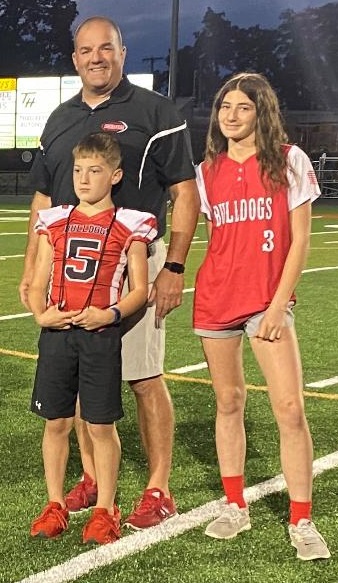 Roy also implements ideas he hears at various conferences.
Roy also implements ideas he hears at various conferences.
“I always try to network and find out who’s doing something better than I’m doing and borrow that,” he said. “The neat thing about athletic directors in our association is we’re willing to share everything.
“We’re different than coaches who have a secret play or a playbook and don’t want anybody to know those plays.”
He noted that not everyone is cut out to be an athletic director.
“Most think all I do is sit around and eat popcorn, a hot dog and watch contests and how cool that is,” he said, laughing.
He said they do not see the contact with officials and support staff, refilling of concession supplies, setting up transportation to away games, notifying parents of any changes or problems and working on game schedules for next year.
As for non-AD duties, Roy spends time with his two children: Harper, a 5-foot-8 seventh grader whom he coaches on a 12-and-under softball team; and Ryker, a fourth grader involved in football, basketball, wrestling and baseball.
Doing things the right way
Roy said former Gull Lake AD Mike Foster helped craft his philosophy that high school sports are more than just winning.
“To me, in high school educational athletics, we’re here to grow the whole child and just not teach him how to win,” he said.
“I’m hiring my coaches who are going to be the best role models for my kids. We do want to win, because it’s important, but it’s not the ultimate goal for me.”
Speaking of coaches, Roy noted that his mentor is now an employee.
“Funny thing,” he said. “Mike Garvey’s my golf coach here. I always try to surround myself with some talented individuals.”
Garvey said Roy is the only reason he agreed to coach the boys golf team, and he would not consider doing it for anyone else.
“With his coaches, they’re a family and he’s like the patriarch who shows a lot of love and respect,” Garvey said.
***
 Garvey was one of 10 inductees making up the 13th class of the NIAAA Hall of Fame honored in December. Garvey served as an athletic administrator for 24 years through 2018 with stops at Lawton, Delton Kellogg, Otsego and Kalamazoo Hackett Catholic Prep. He received the MHSAA’s Allen W. Bush Award in 2015 and Charles E. Forsythe Award in 2020. He also was an assistant coach on two MHSAA Finals wrestling championship teams and as head coach led Lawton to the Class D title in 1990.
Garvey was one of 10 inductees making up the 13th class of the NIAAA Hall of Fame honored in December. Garvey served as an athletic administrator for 24 years through 2018 with stops at Lawton, Delton Kellogg, Otsego and Kalamazoo Hackett Catholic Prep. He received the MHSAA’s Allen W. Bush Award in 2015 and Charles E. Forsythe Award in 2020. He also was an assistant coach on two MHSAA Finals wrestling championship teams and as head coach led Lawton to the Class D title in 1990.
Garvey has been an active member of both the MIAAA and NIAAA and the Michigan Wrestling Coaches Association, and a member of the faculty for the NIAAA’s Leadership Training Institute while also serving as Michigan’s coordinator for the program. In retirement, he has continued to contribute to school sports in a variety of other ways as well including as a meet manager of the MHSAA’s Team Wrestling Finals at Wings Event Center in Kalamazoo.
Among additional accolades at the state and national levels, Garvey received the NIAAA’s 2016 Distinguished Service Award and the George Lovich State Award of Merit in 2009 from the MIAAA.
 Pam Shebest served as a sportswriter at the Kalamazoo Gazette from 1985-2009 after 11 years part-time with the Gazette while teaching French and English at White Pigeon High School. She can be reached at [email protected] with story ideas for Calhoun, Kalamazoo and Van Buren counties.
Pam Shebest served as a sportswriter at the Kalamazoo Gazette from 1985-2009 after 11 years part-time with the Gazette while teaching French and English at White Pigeon High School. She can be reached at [email protected] with story ideas for Calhoun, Kalamazoo and Van Buren counties.
PHOTOS (Top) Vicksburg athletic director Mike Roy gives much credit to his secretary Rhonda VanderKamp, his assistant during the entirety of his two decades at the school. (Middle) Roy takes a minute to take a photo with Donald Duck during a conference in Orlando, Fla. (Below) Roy and his children Harper and Ryker await the presentation of his MHSAA’s Allen W. Bush Award. (Photos courtesy of Mike Roy.)
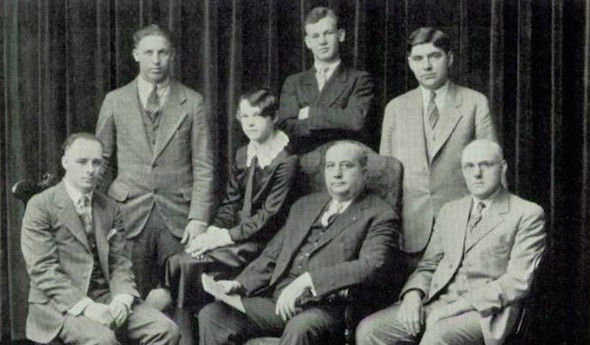
50 Years Later, 'Charlie' Remains Legendary
By
Ron Pesch
MHSAA historian
September 30, 2018
There is no official record of the proceedings, only a short newspaper recap of the event that was hosted 50 years ago at Michigan State’s Kellogg Center. In attendance was a who’s who of high school sports administrators. They were there to honor the man, affectionately known to his friends as “Charlie.”
A parade of guests presented gifts and citations, then sang his praises.
Dr. Clifford Fagan, Executive Secretary of the National Federation of High School Athletics, attended. State Directors of Athletics from Indiana and Ohio were on hand for the Monday, October 7, 1968, celebration.
Dr. Ira Polly, State Superintendent of Public Instruction, called him “noble, honest and courageous.” John F. Toepp, a state senator and radio sports broadcaster from the Cadillac area, “hailed him as ‘Mr. High School Athletics.’”
Sportswriter Bob Gross, six years into his career at the Lansing State Journal, wrote that Charles E. Forsythe, seated next to his wife Josephine, “only grinned with each word of gratitude.”
More than 350 friends attended the testimonial dinner, honoring the second director of the Michigan High School Athletic Association upon his retirement. For 39 years, Forsythe had served the MHSAA, dedicated to bettering the world of high school sports in Michigan and beyond. His years of service would formulate the mold for those who would follow in his footsteps.
“For five minutes they applauded,” wrote Gross, capturing the moment. Forsythe was humbled by the appreciation. When it was his turn to speak, he thanked the assembled crowd.
 “This is a great night. It’s just wonderful so many of you came to my party. I’m deeply honored,” Forsythe said. “I can’t stand here and accept all the thanks. It was teamwork that made our organization go. And, may I ask of all of you to please help make it grow bigger and better than it is.”
“This is a great night. It’s just wonderful so many of you came to my party. I’m deeply honored,” Forsythe said. “I can’t stand here and accept all the thanks. It was teamwork that made our organization go. And, may I ask of all of you to please help make it grow bigger and better than it is.”
The MHSAA had announced Forsythe’s retirement in late May.
With the exception of a 39-month tour as a Navy Commander, assisting former heavyweight boxing champion Gene Tunney in directing Navy physical fitness activities during World War II, Forsythe had been with the Association since July of 1929, originally as an assistant to Alden W. Thompson, the first director of the MHSAA. (Forsythe remains considered the Association’s first fulltime executive director.)
A graduate and prominent athlete at Milan High School, Forsythe earned his undergraduate degree from Michigan State Normal College (today’s Eastern Michigan University) in 1920 and his Master of Arts degree from the University of Michigan in 1926. He coached basketball and baseball at Milan High School during 1922-23 and taught science. He moved to Lansing Central High School the following year, where he taught history. In the fall of 1926, Forsythe was named director of athletics. According to news reports, he was also “one (of) the leading high school football and basketball officials in the state, working in the district and regional basketball tournaments …”
In his introduction of Forsythe as his new assistant, Thompson said “his presence in this office will make it possible to extend the service rendered by the State Association for the ultimate good of the athletic program throughout the state. The growth of the basketball tournaments, the addition of regional track meets as well as tournaments in tennis and golf, and state association participation in swimming and cross country have all added to the details of business handled through the office of the state director …”
In his book, “Athletics in Michigan High Schools: The First Hundred Years” published in 1950, Lewis L. Forsythe noted that additional help definitely was needed. The elder Forsythe, who was Charles’ uncle, was principal of Ann Arbor High School from 1917 until his retirement in 1946. He twice had served as president of the Michigan Interscholastic Athletic Association, the predecessor to the MHSAA. Elected president of the MHSAA Representative Council in 1924, Lewis Forsythe continued serving in that role until 1942. He had seen, first-hand, Thompson’s need for help.
 “Ever since the new association was organized, it had been the wonder of every informed person that Mr. Thompson could stand up under the strain of the work he felt compelled (or impelled) to do. We knew the strain was terrible and unwise,” Lewis Forsythe wrote.
“Ever since the new association was organized, it had been the wonder of every informed person that Mr. Thompson could stand up under the strain of the work he felt compelled (or impelled) to do. We knew the strain was terrible and unwise,” Lewis Forsythe wrote.
“(Charles’) appointment not only relieved Mr. Thompson of a great deal of detail, but enabled the association to enlarge and improve its services to the schools.”
As assistant director, Charlie traveled Michigan, supervising state officials and conducting MHSAA tournaments. While he was in the office, he improved Association communication with member schools by preparing and expanding the State Association Bulletin. When Thompson was appointed to State Director of Health and Physical Education in Michigan in 1931, it opened the door for Forsythe to become director of the MHSAA.
“Thompson had the job of building the Michigan High School Athletic Association ‘from scratch’ and he built very well,” said Charles several years later. “He was thorough in his application of rules and in seeing that they all were interpreted alike both to large and small schools, so no favoritism or any difference were shown.” If there has been any success in the (years I) served, much of it can be credited to the background and good training I received during the period that I served under Thompson …”
In 1939, Forsythe released the first of four editions of his book, “The Administration of High School Athletics.” It quickly found a home as a textbook at various colleges and universities around the country. For 19 summers, he travelled as a visiting lecturer or staff member of the Universities of Michigan, Wisconsin, Ohio State, Southern California, West Virginia, Indiana, Oregon and elsewhere.
In 1941, George Maskin of the Detroit Times wrote about Charlie’s impact after 12 years in the position.
“This Forsythe fellow is a short, stocky gent of 41. There’s a touch of gray circling around the edge of his head, probably caused by the nights he’s stayed awake worrying whether one of his new ventures would turn out successfully,” Maskin wrote.
“There have been some mighty changes, as well as improvements, since Forsythe was hired to boss the preps. But when he talks, Forsythe speaks in terms of ‘we.’ There’s nothing egotistical about Forsythe’s way of doing things. “
Maskin noted some of the achievements that had occurred under the Forsythe regime. During those dozen years, the number of schools competing in Michigan prep sports jumped from 600 to 750. Six-man football had spread to 100 of Michigan’s smaller schools, which formerly passed over the fall sport. Under Forsythe’s leadership, local and regional tournaments in basketball play increased, “thus reducing the amount of traveling and time lost from school during the state championships.” A team competing in state tournament basketball games would play no more than one game per day – against two in other states adjoining Michigan. Minor sports – tennis, golf, cross country, swimming – had come into their own. Forsythe recognized their value in drawing additional students into athletics and increasing athletic participation. He would take that knowledge with him when he entered the Navy (and would return from the service with an even broader view of their value).
 Yet, perhaps his greatest achievement was his emphasis on safety in sports.
Yet, perhaps his greatest achievement was his emphasis on safety in sports.
In 1937, at the 13th annual MHSAA football rules meeting, “leaders drafted a program to address and demonstrate “techniques intended to make football a safer game for high school boys.” A mandatory rule to require “a three minute warm-up on the practice field before the start of the second half of each game” was put in place. The association had recognized that more serious injuries in football occurred at the start of the second half, because players had rested between periods and weren’t stretching out before resuming play. The creation of an accident benefit plan administered by the MHSAA for the state’s athletes had been discussed for six years, but had failed to engage because of a lack of participation. In December of 1939, it was finally ratified. The plan went into effect with the 1940-41 school year and required schools participating in the program to report all injuries. That led to more accurate data, and, in turn, an increased focus on safety and attention to equipment.
“There has been a decided improvement in the type of equipment worn, especially in football” said Forsythe to Maskin in 1954. “Rules have been written much more with the idea of protecting participants than formerly used to be the case.”
In 1961, Forsythe noted that face guards helped reduce the number of eye injuries and fractured noses. In the fall of 1962 a compulsory mouth guard rule went into effect in football, resulting in a 58-percent reduction in claims filed against the plan for dental injuries.
But at the time of his retirement, it was still apparent that the state basketball tournament was Forsythe’s pride and joy, and the event that allowed the MHSAA to function financially. Attendance at all District, Regional and Final games in 1930 was 126,000. At the time of his retirement in 1968, postseason attendance topped 775,000.
“I remember the time when we used to have to advertise to try to get people to come to our Finals,” said Forsythe to an Associated Press reporter shortly before his final day. “Now they all are automatic sellouts before the games are played,”
Tighter regulation reduced the use of illegal players, as seen in the earliest years of the tournament.
“Some of the coaches used to go out recruiting,” continued Forsythe. “… In the old days, we were more of a police agency. The coaches would try anything they thought they could get by with. Now they generally ask us first or turn themselves in if they discover they are playing a boy who is ineligible.”
“At 69, he still looks fit enough to play running instead of standing guard in any basketball game. He credits this mostly to a strict diet and sensible exercise, such as working in his garden. Forsythe also plans some traveling. “I might take in next year’s basketball finals,” he added with a grin, “If I can get a ticket.”
But a return trip to Michigan State University’s Jenison Field House, home to the MHSAA Basketball Finals since 1940, wasn’t in the cards. The September 1968 issue of the MHSAA Bulletin featured Forsythe on the cover, celebrating his career. In December, he passed away unexpectedly at his Lansing home. The February 1969 Bulletin presented a memoriam, praising his service and “his keen appraisal of athletics, their place in our society and their administration.”
With the August retirement of John E. “Jack” Roberts after 32 years of service, and the appointment of Mark Uyl as executive director, there have been only seven executive directors since the MHSAA was formed in 1924. Beside Thompson and Forsythe, Julian Smith handled the organization between 1943 and 1944 during Forsythe’s military service. Allen W. Bush (1968-78), who served as an MHSAA assistant for eight years to Forsythe, was followed by Vern Norris (1978-86).
 Ron Pesch has taken an active role in researching the history of MHSAA events since 1985 and began writing for MHSAA Finals programs in 1986, adding additional features and "flashbacks" in 1992. He inherited the title of MHSAA historian from the late Dick Kishpaugh following the 1993-94 school year, and resides in Muskegon. Contact him at [email protected] with ideas for historical articles.
Ron Pesch has taken an active role in researching the history of MHSAA events since 1985 and began writing for MHSAA Finals programs in 1986, adding additional features and "flashbacks" in 1992. He inherited the title of MHSAA historian from the late Dick Kishpaugh following the 1993-94 school year, and resides in Muskegon. Contact him at [email protected] with ideas for historical articles.
PHOTOS: (Top) Charlie Forsythe, standing far right, served at Lansing Central at the time of this photo in 1927. (Top middle) Forsythe in 1938. (Middle) MHSAA Executive Director Alden Thompson. (Below) Forsythe. (Photos gathered by Ron Pesch.)

